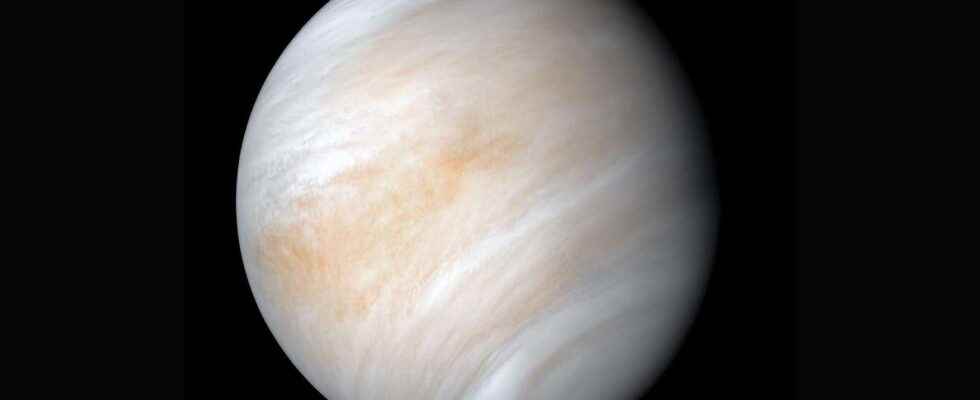Despite its inhospitable appearance, Venus could be capable of harboring life, especially in its atmosphere: unexplained chemical anomalies are detected there, including the possible presence of ammonia. MIT researchers are proposing a chain of chemical processes capable, from the simple presence of ammonia (of potentially biological origin in the study), of neutralizing the acidic environment of the atmosphere.
You will also be interested
[EN VIDÉO] Magellan reveals the topography of Venus This visualization is a brief tour of the overall terrain of the planet Venus as revealed by radar aboard the Magellan spacecraft. The terrain elevation is color coded, with blues and greens representing low elevations and reds representing high elevations. The two great “continents”, or highlands, Aphrodite Terra and Ishtar Terra, the Maxwell Montes mountain range and Maat Mons, a large currently dormant volcano, are highlighted.
Sometimes nicknamed the “sister planet of Earth” because of some of their similarities (size, mass, composition), Venus is our closest planetary neighbor. With an average temperature of 460 ° C, its surface is constantly swept by winds blowing at nearly 100 m / s, creating conditions largely unfavorable to the survival of any Life form known. As for his atmosphere, it is made up of 96% of carbon dioxide, and is much denser than the Earth’s atmosphere, with a pressure ground level of 93 bars (nearly 93 times the pressure at the Earth’s surface). It also features thick clouds dioxide compounds sulfur and droplets of sulfuric acid, sometimes causing sulfuric acid rains (which are also evaporated before they can reach the surface).
An inhospitable planet suspected of harboring conditions conducive to life?
Despite these uninviting characteristics, several parameters lead to the scientists to suspect Venus to be able to shelter life, in particular in its atmosphere: first, at approximately 50 kilometers of altitude, the pressure and the temperature are similar to those of the surface of the Earth (approximately 1 bar, and a temperature varying from 0 at 50 ° C), providing much milder conditions than on the Venusian surface. In addition, anomalies Chemicals that remain unexplained have been detected in Venusian clouds, such as the presence of low oxygen levels, non-spherical particles (as opposed to spherical droplets of sulfuric acid), and even small concentrations of water vapor. The vertical profiles of sulfur dioxide and water vapor abundance in the atmosphere of Venus also seem difficult to explain. Even more intriguing, the presence ofammonia was briefly detected there in the 1970s by the Venera 8 and Pioneer Venus probes, but its origin in the Venusian atmosphere remains unexplained.
MIT scientists (Massachusetts Institute of Technology), Cardiff University and Cambridge University, sought to identify chemical reactions taking place in Venusian atmosphere to explain the anomalies observed. In their model, the reactions are generated by the presence of ammonia, which would trigger by the domino effect chemical reactions capable on the one hand of explaining the anomalies detected, but also of neutralizing the sulfuric acid droplets: Dissolving in the droplets of sulfuric acid, ammonia could neutralize the acid and trap sulfur dioxide in the form of ammonium sulfite salts. This trapping of sulfur dioxide would explain the anomaly of its vertical abundance. The droplets containing ammonium salts would then have conditions analogous to the environments acidophilus terrestrial, making them “potentially habitable”.
A biological origin for ammonia?
Although the source of ammonia is currently unknown, scientists predict that its presence could involve biological production, having been unable to explain it by other non-biological processes such as volcanism or the lightning. In addition, ammonia (NH3) contains hydrogen, which is only present in very small quantities in the atmosphere of Venus: a gas that does not belong to its environment is easily suspected of being linked to biological processes.
If Venusian ammonia is indeed produced by some form of life, the scientists involved in the study take their model even further: the most energy-efficient ammonia-producing reaction would also produce oxygen, to explain the detection of O2 in cloud layers.
This model therefore demonstrates the possibility of chemical processes largely explaining the anomalies detected in the Venusian atmosphere, but also involving a biological source capable of producing ammonia, making the conditions more favorable for the survival of any form of life. In short, this study suggests that life could create its own environment on Venus. This hypothesis is appealing, and scientists have compiled a list of chemical signatures on which future missions to the clouds of Venus (including missions Venus Life Finder) should focus on trying to verify it.
Interested in what you just read?
.
fs3
